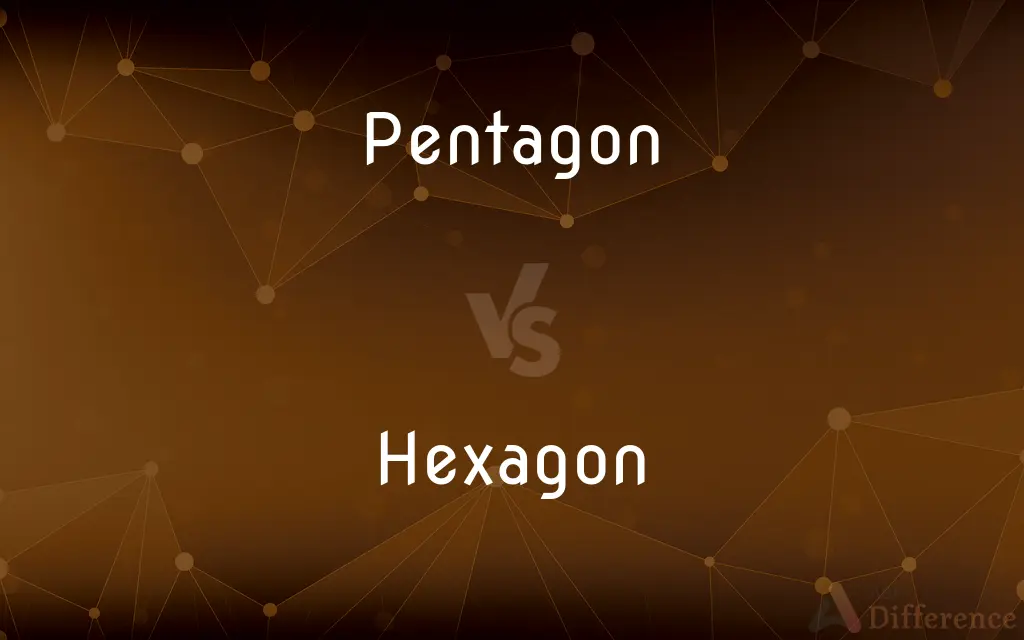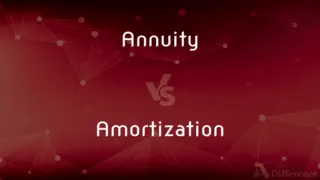Pentagon vs. Hexagon — What's the Difference?
Edited by Tayyaba Rehman — By Urooj Arif — Updated on March 17, 2024
A pentagon is a five-sided polygon, while a hexagon is a six-sided polygon, each defined by the number of its edges.

Difference Between Pentagon and Hexagon
Table of Contents
ADVERTISEMENT
Key Differences
A pentagon, characterized by its five sides and five angles, can come in various forms, including regular (all sides and angles equal) and irregular. In contrast, a hexagon has six sides and six angles, with the regular hexagon featuring sides and angles of equal measure. This difference in the number of sides and angles directly affects their geometrical properties and symmetry.
The regular pentagon is notable for its aesthetic and structural applications, such as in historical buildings and as a symbol in various cultures. On the other hand, the regular hexagon is often observed in nature, such as in honeycomb patterns, and is known for its efficiency in tiling and packing problems due to its unique geometrical properties.
In terms of interior angles, a pentagon, regardless of being regular or irregular, has interior angles that add up to 540 degrees. Meanwhile, a hexagon's interior angles sum up to 720 degrees, showcasing how the geometry of each shape affects its internal angle sum.
The regular pentagon is associated with the golden ratio, particularly in the relationships between its sides and diagonals, which appeals to both mathematical beauty and architectural design. Whereas, the regular hexagon is efficiently tessellatable, meaning it can fill a plane without gaps or overlaps, which is a property not shared with regular pentagons.
Pentagons and hexagons both play significant roles in art and design, but the hexagon is particularly noted for its structural efficiency, making it a common pattern in engineering and design due to its strength and compactness.
ADVERTISEMENT
Comparison Chart
Sides
Five
Six
Interior Angles
Sum to 540 degrees
Sum to 720 degrees
Symmetry
Less than hexagon in regular form
More, due to six axes of symmetry
Nature Presence
Less common
Common in honeycombs, crystals
Tiling Ability
Cannot tile a plane without gaps
Can efficiently tile a plane
Compare with Definitions
Pentagon
A polygon with five sides and angles.
The classroom activity involved drawing a perfect pentagon.
Hexagon
The sum of its interior angles is 720 degrees.
They explored hexagons by adding up their interior angles.
Pentagon
The sum of its interior angles is always 540 degrees.
We calculated the missing angle of the pentagon.
Hexagon
A six-sided polygon with equal or unequal sides.
Beehives are composed of hexagonally shaped cells.
Pentagon
Can be regular (equal sides and angles) or irregular.
Most star shapes are made of intersecting pentagons.
Hexagon
Regular hexagons have all sides and angles equal.
The board game used tiles shaped as regular hexagons.
Pentagon
Symbolic in various cultures.
The pentagon is often used in military insignias.
Hexagon
Seen in nature and efficient in packing problems.
Hexagonal patterns are optimal for storage space utilization.
Pentagon
Used in architectural and design contexts for its aesthetic.
The pentagon-shaped tiles added uniqueness to the décor.
Hexagon
Common in engineering due to its strength and compactness.
The bridge's design featured hexagonal supports for added stability.
Pentagon
In geometry, a pentagon (from the Greek πέντε pente and γωνία gonia, meaning five and angle) is any five-sided polygon or 5-gon. The sum of the internal angles in a simple pentagon is 540°.
Hexagon
A polygon with six sides and six angles.
Pentagon
A polygon with five sides and five angles.
Hexagon
In geometry, a hexagon (from Greek ἕξ, hex, meaning "six", and γωνία, gonía, meaning "corner, angle") is a six-sided polygon or 6-gon. The total of the internal angles of any simple (non-self-intersecting) hexagon is 720°.
Pentagon
Pentagon A five-sided building near Washington DC, containing the US Department of Defense and the offices of the US Armed Forces. Used with the.
Hexagon
A plane figure with six straight sides and angles.
Pentagon
(geometry) A polygon with five sides and five angles.
Hexagon
(geometry) A polygon with six sides and six angles.
Pentagon
A fort with five bastions.
Hexagon
A plane figure of six angles.
Pentagon
A plane figure having five angles, and, consequently, five sides; any figure having five angles.
Hexagon
A six-sided polygon
Pentagon
A government building with five sides that serves as the headquarters of the United States Department of Defense
Pentagon
The United States military establishment
Pentagon
A five-sided polygon
Common Curiosities
Where are hexagonal patterns commonly found in nature?
Hexagonal patterns are notably found in honeycombs and certain crystal structures.
Why might a designer choose a hexagonal pattern over a pentagonal one?
A designer might choose hexagons for their tiling efficiency and structural compactness.
Can irregular pentagons and hexagons still be identified by their side count?
Yes, regardless of regularity, the defining feature is the number of sides.
What is the significance of pentagons in architecture?
Pentagons are celebrated for their aesthetic appeal and relation to the golden ratio.
What educational activities might involve pentagons and hexagons?
Activities could include geometry lessons on polygons, art projects, and nature studies.
What distinguishes a pentagon from a hexagon?
The main difference is the number of sides: a pentagon has five, while a hexagon has six.
How are the interior angles of a pentagon and hexagon calculated?
The sum of interior angles in a pentagon is 540 degrees, while in a hexagon, it's 720 degrees.
Can both pentagons and hexagons be regular?
Yes, both can be regular, meaning all sides and angles are equal.
Why do hexagons tile perfectly but pentagons do not?
Hexagons can fit together without gaps due to their six-sided symmetry, unlike pentagons.
How do pentagons and hexagons contribute to geometric art?
Both shapes are used for their aesthetic qualities and symbolic meanings in geometric art.
Are there any mathematical puzzles or problems associated with pentagons and hexagons?
Yes, both shapes are central to various mathematical puzzles and tiling problems.
Why is the golden ratio significant to pentagons?
The golden ratio is seen in the proportions of a regular pentagon, adding to its aesthetic and mathematical interest.
Can pentagons be used in tessellation with other shapes?
Yes, although pentagons cannot tile a plane alone, they can be part of a tessellation with other shapes.
How do hexagons aid in structural engineering?
Their ability to distribute force evenly makes hexagons ideal for structural applications.
What role do pentagons play in cultural symbols?
Pentagons are prevalent in many cultural symbols, including military insignias and religious icons.
Share Your Discovery

Previous Comparison
Release vs. Disclaimer
Next Comparison
Annuity vs. AmortizationAuthor Spotlight
Written by
Urooj ArifUrooj is a skilled content writer at Ask Difference, known for her exceptional ability to simplify complex topics into engaging and informative content. With a passion for research and a flair for clear, concise writing, she consistently delivers articles that resonate with our diverse audience.
Edited by
Tayyaba RehmanTayyaba Rehman is a distinguished writer, currently serving as a primary contributor to askdifference.com. As a researcher in semantics and etymology, Tayyaba's passion for the complexity of languages and their distinctions has found a perfect home on the platform. Tayyaba delves into the intricacies of language, distinguishing between commonly confused words and phrases, thereby providing clarity for readers worldwide.














































